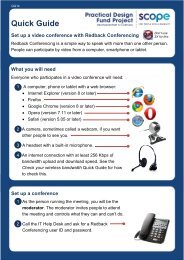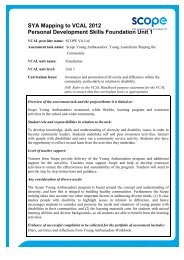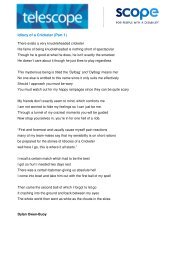Positive behaviour support Getting it right from the start
Positive behaviour support Getting it right from the start
Positive behaviour support Getting it right from the start
You also want an ePaper? Increase the reach of your titles
YUMPU automatically turns print PDFs into web optimized ePapers that Google loves.
<strong>Pos<strong>it</strong>ive</strong> <strong>behaviour</strong> <strong>support</strong>: <strong>Getting</strong> <strong>it</strong> <strong>right</strong> <strong>from</strong> <strong>the</strong> <strong>start</strong> - Facil<strong>it</strong>ators reference manual 63<br />
Motivation assessment scale 20<br />
The MAS consists of 16 <strong>it</strong>ems describing various <strong>behaviour</strong>s which a respondent (family member<br />
or staff) is required to rate on a six-point scale according to how <strong>the</strong>y believe <strong>the</strong> person would<br />
behave in a variety of different s<strong>it</strong>uations. The results are tallied according to four <strong>the</strong>oretical<br />
categories said to suggest <strong>the</strong> possible motivation underlying a person’s <strong>behaviour</strong>. Like any<br />
assessment tool, <strong>the</strong> MAS should be used regularly to check if your ideas about why <strong>the</strong><br />
<strong>behaviour</strong> is occurring are correct.<br />
Name:<br />
Rater:<br />
Date:<br />
Description of <strong>behaviour</strong> (be specific):<br />
Instructions: The MAS is a questionnaire designed to identify those s<strong>it</strong>uations where an<br />
individual is likely to behave in specific ways. From this information, more informed decisions<br />
can be made about <strong>the</strong> selections of appropriate replacement <strong>behaviour</strong>s. To complete <strong>the</strong><br />
MAS, select one target <strong>behaviour</strong>. Be specific about <strong>the</strong> <strong>behaviour</strong>. For example ‘is aggressive’<br />
is not as good a description as ‘h<strong>it</strong>s o<strong>the</strong>r people’. Once you have specified <strong>the</strong> <strong>behaviour</strong><br />
to be rated, read each question carefully and circle <strong>the</strong> one number that best describes your<br />
observations of this <strong>behaviour</strong>. The column w<strong>it</strong>h <strong>the</strong> highest score indicates <strong>the</strong> reason why <strong>the</strong><br />
<strong>behaviour</strong> is occurring.<br />
20. Durand and Crimmins 1992.

















